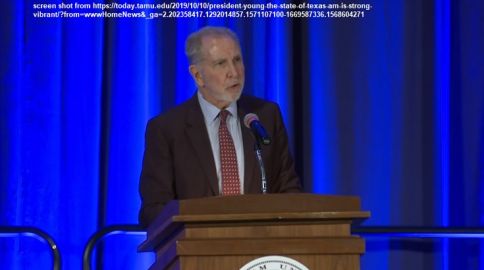
The annual state of Texas A&M address from president Michael Young included the announcement of a new ten year strategic plan, which will be led by the provost and will begin with a series of open forums.
That announcement comes three days after provost Carol Fierke was in Minneapolis interview for a similar position at the University of Minnesota.
The president also announced the addition of the university’s fourth strategic pillar…community. Young became emotional while describing the community’s reaction to last December’s passing of president George H.W. Bush.
Young also announced A&M’s $4 billion dollar capital campaign, which will end next year, is now at $3.6 billion.
Click HERE to be directed to the video of Michael Young’s state of the university address.
Click below to listen to Michael Young’s state of the university address:
Listen to “Texas A&M President Michael Young's State of the University address” on Spreaker.
News release from Texas A&M:
Texas A&M University President Michael K. Young reflected on a year of successes and announced more than $91 million worth of new investment priorities and grants during his 2019 State of the University Address at the Memorial Student Center.
“Because of your efforts and contributions, the state of the university is strong and vibrant. That is not to say that we are without challenges,” Young said. “We as Aggies are conditioned to face and overcome challenges, to strive for excellence every day, to celebrate success and plan for more.”
Young divided his address into three segments: why now matters, who we are and what we will do next.
Why now matters
Young provided an update to the campus community on two major initiatives that will conclude next year: Vision 2020 and the Lead by Example campaign. He thanked the “visionary, prescient Aggies” involved in creating the strategic plan in 1998 that led to the university’s designation as a tier-one research university and a member of the Association of American Universities.
Young also announced that the Lead by Example campaign, which publicly launched in 2015 with an ambitious goal to raise $4 billion to support the university’s three pillars, has raised $3.6 billion.
“These vital funds help our students, faculty and staff have the resources they need to continue the pursuit of excellence as a world-class university,” Young said. “We are very grateful to our former students who have gone on to great success, and then choose to give back to help future Aggies and our great university.”
In addition to meeting a major fundraising milestone, Young noted that research conducted at Texas A&M represented annual expenditures of $922 million in fiscal year 2018, the largest in the university’s history. And the university received its largest-ever investment from the Texas Legislature of $91 million additional dollars for students over the next two years.
Who we are
While the Texas A&M community has grown to more than 69,000 students, making it the largest in the nation, Young underscored the need for the university to maintain its high teaching and research standards.
“While we have experienced growth, we have also continued to enhance the quality of education. I think that this is important to point out,” Young said. “Growth with quality, not at the expense of quality.”
Young said the university plans to maintain a high level of quality by investing in buildings and the people who work and learn inside of them. He pointed to completed projects that include the state-of-the-art Zachry Engineering Education Complex and the Music Activities Center as recent examples of investment, and the forthcoming Student Services Building and 21st Century Classroom Building as examples of what the future holds. Young noted that the new buildings go hand-in-hand with the investment of more than $100 million annually in maintenance for existing facilities.
In addition to buildings dedicated to teaching and research, Young announced that plans are in place for a project tentatively titled Aggie Park to “enhance the beauty of campus as well as provide space for a broad range of student activities including concerts, lectures, and Aggie Ring Day.”
“This investment is necessary to ensure that we serve that growth and continue to provide the highest quality educational environment possible,” Young said. “All of this construction allows us to grow our capacity to achieve at the highest levels across our three missions: student learning, research and discovery, and impact.”
What we will do next
Young used the final portion of his address to discuss at length six priorities for investment in the coming years that were made possible by a landmark Texas legislative session:
• Faculty investment
• Student Success Initiative
• Graduate Education
• Emerging areas of critical research
• Academic innovation
• Staff advancement
With faculty investment being the university’s top priority, Young said the university will invest $10 million per year to hire an additional 100 or more faculty members, and that new Clinical Research Partnership Grants will total $1 million per year for the remaining eight years of the President’s Excellence Fund.
The second priority, the Student Success Initiative, will see an investment of $5 million per year to focus on retention, graduation rates, time-to-graduation, learning outcomes and placement.
“Students are at the heart of our enterprise,” Young said. “We must do everything possible to ensure their success.”
Young’s third priority, graduate education, will also see a $5 million per-year investment.
His fourth priority of emerging areas of critical research will see a $5 million per-year investment to support research including data science, artificial intelligence, and cybersecurity and technology commercialization.
Academic innovation, the fifth priority, will receive $1 million per year through investment in Presidential Transformational Teaching Grants. The grants will be funded annually at $1 million per year for the remaining eight years of the President’s Excellence Fund for a total of an additional $8 million, funding 30 projects, each lasting two years. Another $1.5 million will support academic innovation in areas of instructional design, online learning experiences, enhanced data analytics and lifetime learning.
For the sixth and final priority of staff advancement, Young said university staff can expect to see the rollout of a program called “Flourish,” which will include new faculty and staff onboarding processes, wellness and other support programs.
“In the end, this is about supporting all employees to achieve their greatest career potential and have the highest level of health and wellbeing possible,” Young said.
Looking beyond the six strategic investment priorities, Young turned the attention of each address attendee to the future, encouraging them to take part in one of four Strategic Planning Forums chaired by Provost & Executive Vice President Carol A. Fierke. Feedback in the forums will help inform a university strategic plan that will guide the university through 2030.
A fourth strategic pillar
Young wound down his remarks by noting that each of the areas covered during his address align with the university’s three Strategic Pillars:
• Transformational Education
• Discovery and Innovation
• Impact on the state, nation and the world
“As we have progressed and grown, it has become increasingly clear that our ability to achieve our goals is intimately and directly related to our capacity to come together as a community,” Young said.
To cement the role that “community” plays in the university, Young formally announced its addition as a fourth pillar, noting that Texas A&M is “committed to enriching the learning and working environment for all visitors, students, faculty and staff.”
“The Aggie citizen is a citizen of substance, forever demonstrating a willingness to help humanity, with an abiding commitment to the success of each other,” Young said.
Young pointed to the passing of President George H.W. Bush and his burial on the grounds of the Bush Library as an example of the power of Texas A&M’s community, noting that President Bush requested the “Aggie War Hymn” be played while his coffin was removed from the train that carried him into Bryan-College Station.
“I truly believe his choice of playing ‘The Aggie War Hymn’ was one last message to us,” Young said. “It was an ‘I love you’ for who you are, what you do and what you stand for. One last ‘I love you’ to Aggies everywhere.”
Optimism for the future
In closing, Young thanked the university community in attendance for their contributions over the past year.
“As we move into 2020 with vigor and a firm commitment to the success of this institution and each other, let us be grateful for what we have been given, optimistic about the future, and enthusiastic about serving our university, community, state, nation and world,” Young said.
